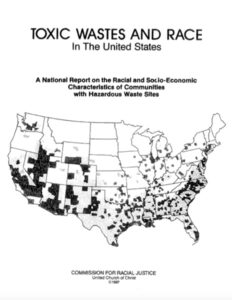Reducing Environmental and Occupational Cancer Risks Toolkit
Module 5: Advancing Health Equity with Environmental Justice
1. WHAT IS ENVIRONMENTAL JUSTICE?
The U.S. Environmental Protection Agency (EPA) defines environmental justice as:
“The just treatment and meaningful involvement of all people, regardless of race, color, national origin, Tribal affiliation, or disability, in agency decision-making and other federal activities that affect human health and the environment so that people:
Just treatment means that no group of people should bear a disproportionate share of the negative environmental consequences resulting from industrial, governmental, and commercial operations or policies.
Environmental justice or moreover, environmental injustices, may be unknown, or under-utilized terms in your cancer coalition. More common terms in discussions about reducing cancer risk are social determinants of health and health equity. Environmental exposures are among the social determinants of health and related to health equity. Consequently, your respective cancer coalitions are likely already involved in environmental justice-related work, though they may not identify it as such.
States have developed their own definitions of environmental justice. They are often based on residential neighborhoods characterized as predominantly low income and/or people of color. Some states have also included other socio-demographic indicators, such as limited English speaking, high unemployment rate and less than a high school education.
The Origins of Environmental Justice
The environmental justice movement was started by individuals, primarily people of color, who sought to address inequities in environmental protection in their communities. The concept and movements associated with environmental justice are widely known to have emerged in the 1980s, but the Civil Rights Movement of the 1960s included many messages about public health dangers. Professor Robert Bullard, the father of the environmental justice movement wrote:
“Whether by conscious design or institutional neglect, communities of color in urban ghettos, in rural ‘poverty pockets’, or on economically impoverished Native-American reservations face some of the worst environmental devastation in the nation.”
In 1982, a group of community members of Warren County in North Carolina, civil rights leaders, and environmental advocates protested the construction of a polychlorinated biphenyl (PCB) landfill in in Afton, North Carolina – a predominately Black community. Ultimately, their efforts were unsuccessful in halting the construction of the landfill site, but the event is widely regarded as the catalyst for today’s environmental justice movement.

In 1987, the United Church of Christ Commission for Racial Justice released their Toxic Wastes and Race report which demonstrated a direct relationship between the siting of toxic waste facilities and communities of poverty and/or color. Indeed, race is the most significant predictor of the location of hazardous waste facilities. A follow up report, Toxic Wastes and Race at Twenty, 1987-2007: Grassroots Struggles to Dismantle Environmental Racism in the United States, was released 20 years after the original. The updated report sought to measure the impact of environmental racism and progress achieved over the last 20 years. The report demonstrated that environmental laws did not protect communities of color any more than they did 20 years ago when the original report was commissioned.
With the tumultuous history and modern manifestations of environmental justice, there have been landmark federal investments in environmental justice: the Inflation Reduction Act, American Rescue Plan, and most recently, the Justice 40 initiative, which has a goal that 40 percent of the overall benefits of certain Federal investments flow to disadvantaged communities that are marginalized, underserved, and overburdened by pollution.
Interested in sharing a video primer on environmental justice with your cancer coalition? Click to watch: